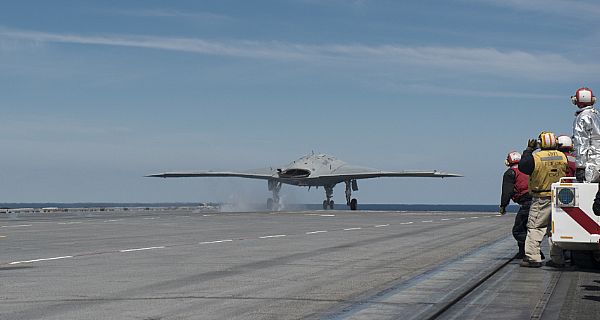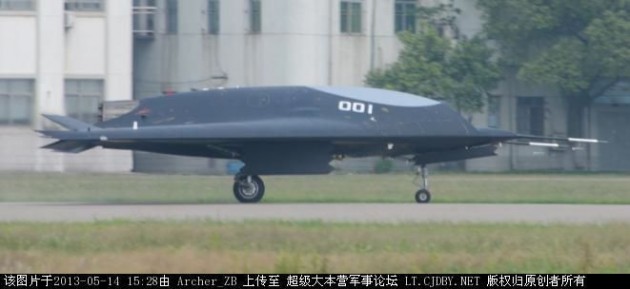Navy Drone’s Next Test: X-47B Will Land, Sort Of; China Unveils Similar Drone
Posted on

[Corrected description of Navy test sequence] Unmanned aircraft are relatively easy to fly. Landing one without crashing is hard. Getting one to take off from the narrow, pitching deck of an aircraft carrier is harder still. Landing on a carrier? That’s hard enough to give human pilots nervous breakdowns. Soon, it will be the final test of the Navy’s prototype carrier-based drone, the X-47B.
[click here for video of the drone’s “touch and go” landing Friday]
While the X-47B made history yesterday with its first launch from an aircraft carrier, the preparation for landing on a pitching carrier deck has not been entirely smooth. In a series of tests using a simulated carrier deck on land, the Navy and contractor Northrop Grumman have repeatedly had to redesign its tail hook. That’s the component unique to carrier aircraft that allows them to snag one of a series of wires on the carrier flight deck. The wire, in turn, is part of a complex system of cables, brakes, and shock absorbers called the “arresting gear,” whose job it is to slow the incoming aircraft to a screeching halt before it runs off the end of the flight deck and splats into the water. (A Navy Nimitz-class supercarrier is 1,000 feet long: Runways at Air Force bases and civilian airports are typically about 10,000 feet, and fighter pilots still occasionally run off the end). This whole teeth-shaking, spine-wrenching process of carrier landing is called a “trap” and is sometimes likened describe as less of a landing and more of a “controlled crash.”
Navy officials sound confident about the landing, but they’re still taking it slow. The X-47B will fly back to the carrier “later this week,” Capt. Jaime Engdahl, the Navy’s X-47B program manager, told reporters this morning. It will perform not a full carrier landing, but rather what is called a “touch and go.” The X-47B will take off from shore, come in to the carrier as if for a landing, and its wheels will hit the carrier deck, but it won’t try to actually catch the arrestor cable. Instead, it will ramp its engine power back up and fly back up into the sky without having landed. Only once it’s done a touch and go successfully, Engdahl explained, will the X-47B attempt an outright carrier landing, “later this summer.”
Is it usual for a Navy aircraft to do a touch-and-go landing on the carrier first, before trying an actual landing? Does the Navy test manned aircraft that way? “Usually we don’t,” Capt. Engdahl acknowledged when I asked him on the conference call.
But the issue isn’t the tailhook, he said. “Hooking the wire and stopping the aircraft, that’s a simple mechanical event,” he said. “The technology that we’re developing, the technology that’s most critical to convey to future unmanned systems, is the precision unmanned system, the flight controls, and the ability to land it on the flight deck.”
For manned aircraft, Engdahl explained, the crucial thing to test is that “mechanical event,” the physical ability of the tailhook to snag the arrestor cable and of the whole aircraft to handle the stress. That’s because, for manned aircraft, the control system that orients the plane in three dimensions, lines it up with the carrier and lands it is proven technology: It’s called the human brain, it’s been maneuvering objects through space for several million years, and it’s been landing planes on carriers since 1918.
The abilities of the X-47B’s robotic brain, however, still need to be proven to the absolute satisfaction of Navy safety officers. “The most technologically demanding and significant [task] is actually touching down on a moving flight deck… while the aircraft and the carrier are pitching and rolling,” Engdahl said.
What’s subtly remarkable about the X-47B is how much more autonomous it is than other unmanned aircraft, not just in take-off and landing but in flight as well. Most drones, such as the famous Predator, are really “remotely piloted aircraft” or RPA: There isn’t anyone on board, but there is a human being somewhere at a ground control station, sitting at a control panel with a joystick, throttle, and other controls, flying the aircraft by remote control, much like a video game. Without constant input from a human operator, an RPA will just keep on going in a straight line or, if its onboard computer realizes it has “lost link” with ground control, it will automatically go into a holding pattern and wait. If the humans can’t get back in contact with the drone, it will keep flying circles in the air until it runs out of gas and crashes. (Or it may self-destruct).
The X-47B is in constant communications with a human on the ground or on the carrier, but they don’t have a joystick – they use standard computer mice, or, for landings, a specialized hand controller – and they’re not flying it by remote control. They’re giving it commands to perform certain tasks, such as land, abort the landing (a “wave off” in Navy parlance), or fly to a specified point. The robot handles the details – just like a human pilot following instructions from flight control.
“The air vehicle operator always has direct control, always has a direct link to the air vehicle, and always has the ability to direct it to do a certain task, [e.g.] to discontinue an approach or wave off, to turn or climb or to execute another round,” said Engdahl, “[but] the aircraft is always autonomous. It is always thinking about the commands that are given to it and reacting to the commands in one sense or the other.”
That level of autonomy is a major step up from most current drones and the biggest single innovation the X-47B can pass along to subsequent unmanned aircraft programs, whether they’re supposed to land on the carrier or a concrete runway.
Presuming the X-47B succeeds, the next step for the Navy is the proposed UCLASS (Unmanned Carrier-Launched Airborne Surveillance and Strike System). It is supposed to be X-47B’s combat-capable successor. The Navy is counting on the stealthy UCLASS to extend the intelligence, surveillance and reconnaissance (ISR) range and striking power of the carrier air wing to an unprecedented degree to cope with the vast distances of the Pacific and the sophisticated “anti-access/area denial” defenses of a potential high-tech adversary – e.g. China.
None of this has gone unnoticed by China. The People’s Liberation Army recently rolled out its own stealth drone, apparently nicknamed Lu Jian (“Sharp Sword”). It looks rather similar to the X-47B, although that’s much less likely the result of espionage than of the physical requirements of stealth and some judicious Googling of the widely available images of the US aircraft.
 In contrast to blatantly fake fighters and dummy drones trotted out by Iran, the Chinese stealth drone “is probably real,” Heritage Institute analyst Dean Cheng told my colleague Colin Clark in an email this morning. “The Chinese have displayed at least 25 different drone models and variants.”
In contrast to blatantly fake fighters and dummy drones trotted out by Iran, the Chinese stealth drone “is probably real,” Heritage Institute analyst Dean Cheng told my colleague Colin Clark in an email this morning. “The Chinese have displayed at least 25 different drone models and variants.”
“The issue with drones is not whether they can fly (aerodynamics), but what their software is,” he added. “Are these truly autonomous? Are they flown via a datalink, as American drones are ([i.e.] really remotely piloted vehicles)?” If so, how secure is that control link?
The final unknown, concluded Cheng, is why these photos came out now, on the heels of the US Navy test. “It might be a subtle ‘see what we have.’ It might be unauthorized,” he said. “Might be related to X-47B. Might be related to ongoing concerns about the ‘pivot’ [to the Asia-Pacific]. Might be related to domestic issues..”
“No way to know,” Cheng said — for now.
Edited 5:25 pm to correct description of the coming “touch and go” tests.
Subscribe to our newsletter
Promotions, new products and sales. Directly to your inbox.
